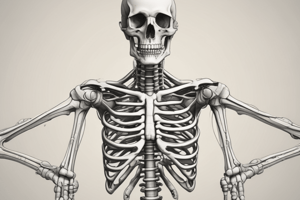Podcast
Questions and Answers
What are some examples of locomotory movements?
What are some examples of locomotory movements?
Walking, running, climbing, flying, swimming are all some forms of locomotory movements.
What is the significance of movement in living beings?
What is the significance of movement in living beings?
Movement is one of the significant features of living beings and is observed in animals and plants.
How are cilia and tentacles utilized in movement? Provide examples.
How are cilia and tentacles utilized in movement? Provide examples.
Cilia and tentacles are used for movement in organisms like Paramoecium, where cilia help in food movement and locomotion, and in Hydra, which uses tentacles for prey capture and locomotion.
How do the methods of locomotion vary in animals?
How do the methods of locomotion vary in animals?
Explain the relationship between movements and locomotion.
Explain the relationship between movements and locomotion.
Flashcards
Locomotion
Locomotion
Movements that allow an organism to change its location in space.
Significance of Movement
Significance of Movement
The ability to move is a defining characteristic of living beings, observed in both animals and plants.
Cilia
Cilia
Tiny hair-like structures used for movement and food gathering, as seen in the single-celled organism Paramoecium.
Tentacles
Tentacles
Signup and view all the flashcards
Locomotion Methods in Animals
Locomotion Methods in Animals
Signup and view all the flashcards
Study Notes
Locomotory Movements
- Examples of locomotory movements include walking, running, swimming, flying, and crawling.
- Locomotory movements are essential for survival, as they enable organisms to search for food, escape predators, and find mates.
Significance of Movement in Living Beings
- Movement is crucial for maintaining homeostasis, regulating body temperature, and facilitating the exchange of gases, nutrients, and waste products.
- It also plays a vital role in development, growth, and reproduction.
Cilia and Tentacles in Movement
- Cilia are short, hair-like structures used for movement in certain microorganisms, such as paramecia, which utilize cilia to propel themselves through water.
- Tentacles are elongated, slender structures used for movement and capture of prey in animals like starfish and sea anemones.
Methods of Locomotion in Animals
- Vertebrates (animals with backbones) use muscles and a skeletal system to facilitate movement, such as walking, running, and swimming.
- Invertebrates (animals without backbones) use a variety of methods, including crawling, slithering, and flying, often relying on muscles and a hydrostatic skeleton.
- Some animals, like mollusks and echinoderms, use foot muscles to move, while others, like arachnids and crustaceans, use leg muscles.
Relationship between Movements and Locomotion
- Locomotion is a specific type of movement that involves the displacement of an organism from one place to another.
- Movement is a broader term that encompasses all types of muscular activity, including locomotion, but also includes other actions like feeding, grasping, and manipulating objects.
Studying That Suits You
Use AI to generate personalized quizzes and flashcards to suit your learning preferences.




